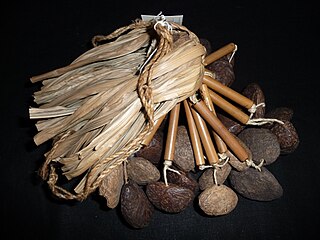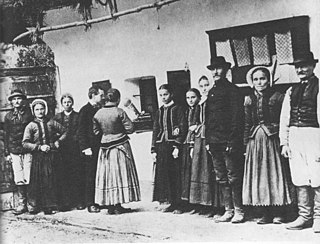
A drum kit — also called a drum set, trap set, or simply drums — is a collection of drums and other percussion instruments, typically cymbals, which are set up on stands to be played by a single player, with drumsticks held in both hands, and the feet operating pedals that control the hi-hat cymbal and the beater for the bass drum. A drum kit consists of a mix of drums and idiophones – most significantly cymbals, but can also include the woodblock and cowbell. In the 2000s, some kits also include electronic instruments. Also, both hybrid and entirely electronic kits are used.

The guitar is a fretted musical instrument that usually has six strings. It is typically played with both hands by strumming or plucking the strings with either a guitar pick or the finger(s)/fingernails of one hand, while simultaneously fretting with the fingers of the other hand. The sound of the vibrating strings is projected either acoustically, by means of the hollow chamber of the guitar, or through an electrical amplifier and a speaker.

The tambourine is a musical instrument in the percussion family consisting of a frame, often of wood or plastic, with pairs of small metal jingles, called "zills". Classically the term tambourine denotes an instrument with a drumhead, though some variants may not have a head at all. Tambourines are often used with regular percussion sets. They can be mounted, for example on a stand as part of a drum kit, or they can be held in the hands and played by tapping or hitting the instrument.

The xylophone is a musical instrument in the percussion family that consists of wooden bars struck by mallets. Each bar is an idiophone tuned to a pitch of a musical scale, whether pentatonic or heptatonic in the case of many African and Asian instruments, diatonic in many western children's instruments, or chromatic for orchestral use.

A glockenspiel is a percussion instrument composed of a set of tuned keys arranged in the fashion of the keyboard of a piano. In this way, it is similar to the xylophone; however, the xylophone's bars are made of wood, while the glockenspiel's are metal plates or tubes, thus making it a metallophone. The glockenspiel, moreover, is usually smaller and higher in pitch.

The güiro is a Latin American percussion instrument consisting of an open-ended, hollow gourd with parallel notches cut in one side. It is played by rubbing a stick or tines along the notches to produce a ratchet sound.
A membranophone is any musical instrument which produces sound primarily by way of a vibrating stretched membrane. It is one of the four main divisions of instruments in the original Hornbostel-Sachs scheme of musical instrument classification.

An idiophone is any musical instrument that creates sound primarily by the instrument as a whole vibrating—without the use of strings or membranes. It is the first of the four main divisions in the original Hornbostel–Sachs scheme of musical instrument classification. The early classification of Victor-Charles Mahillon called this group of instruments autophones. The most common are struck idiophones, or concussion idiophones, which are made to vibrate by being struck, either directly with a stick or hand or indirectly, by way of a scraping or shaking motion. Various types of bells fall into both categories. A common plucked idiophone is the Jew's harp.

A wood block is a small slit drum made from a single piece of wood and used as a percussion instrument. The term generally signifies the Western orchestral instrument, though it is related to the ban time-beaters used by the Han Chinese, which is why the Western instrument is sometimes referred to as Chinese woodblock. Alternative names sometimes used in ragtime and jazz are clog box and tap box. In orchestral music scores, wood blocks may be indicated by the French bloc de bois or tambour de bois, German Holzblock or Holzblocktrommel, or Italian cassa di legno.

The davul or atabal or tabl is a large double-headed drum that is played with mallets. It has many names depending on the country and region. These drums are commonly used in the music of Middle East. These drums have both a deep bass sound and a thin treble sound due to their construction and playing style, where different heads and sticks are used to produce different sounds on the same drum.

A rattle is a type of percussion instrument which produces a sound when shaken. Rattles are described in the Hornbostel–Sachs system as Shaken Idiophones or Rattles (112.1).
Iranian musical instruments can be broadly classified into three categories: classical, Western and folk. Most of Persian musical instruments spread in the former Persian Empires states all over the Middle East, Caucasus, Central Asia and through adaptation, relations, and trade, in Europe and far regions of Asia. In ancient era, the Silk road had an effective role in this distribution.

Castanets, also known as clackers or palillos, are a percussion instrument (idiophone), used in Spanish, Kalo, Moorish, Ottoman, Italian, Sephardic, Swiss, and Portuguese music. In ancient Greece and ancient Rome there was a similar instrument called crotalum. The instrument consists of a pair of concave shells joined on one edge by a string. They are held in the hand and used to produce clicks for rhythmic accents or a ripping or rattling sound consisting of a rapid series of clicks. They are traditionally made of hardwood, although fibreglass is becoming increasingly popular.

Hand percussion is a percussion instrument that is held in the hand. They can be made from wood, metal or plastic and are usually either shaken, scraped or tapped with fingers or a stick. It is a useful category in terms of a large percussion orchestra in that it identifies all instruments that are not drums or pitched percussion such as marimba and xylophone.

A stomp box is a simple percussion instrument consisting of a small wooden box placed under the foot, which is tapped or stamped on rhythmically to produce a sound similar to that of a bass drum. A stomp box allows a performer such as a singer or guitar player to create a simple rhythmic self-accompaniment. Stompboxes are most commonly used in American folk and blues music, but they are also used across the musical spectrum.
Traditional Thai musical instruments are the musical instruments used in the traditional and classical music of Thailand. They comprise a wide range of wind, string, and percussion instruments played by both the Thai majority as well as the nation's ethnic minorities.

A khartal or kartal is a percussion instrument of India.
The Loh Tarang is a melodic percussion instrument. It consists of a set of iron circular plates, of different sizes, held in a frame. Each plate is pitched to a note and they are struck with sticks on each hand. 'Tarang' literally means waves. Plates sound depends on the different size of plate and hand movement. Theory is based like Jal-Tarang.

An unpitched percussion instrument is a percussion instrument played in such a way as to produce sounds of indeterminate pitch, or an instrument normally played in this fashion.

















